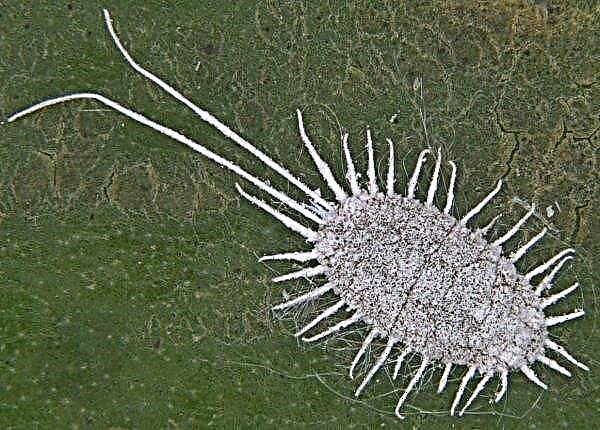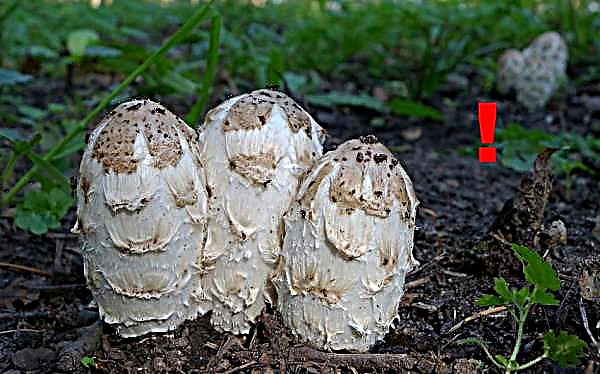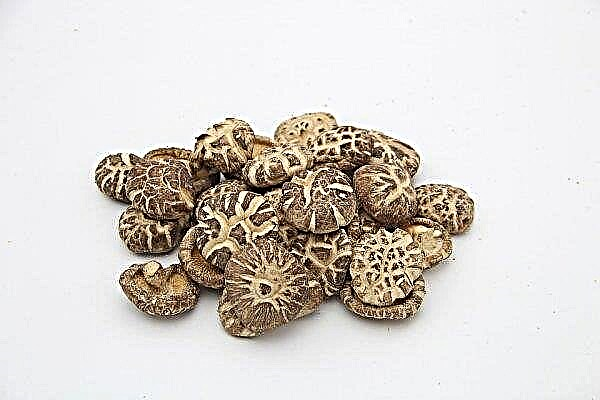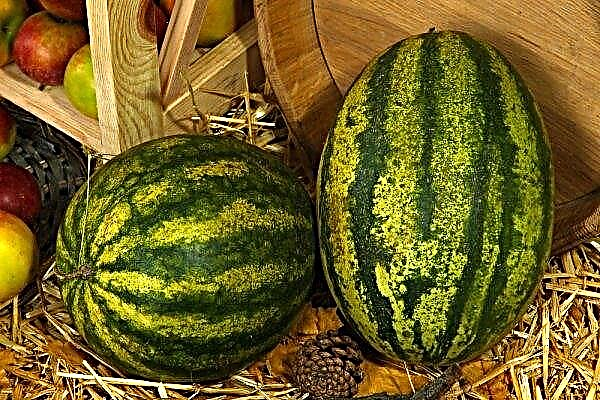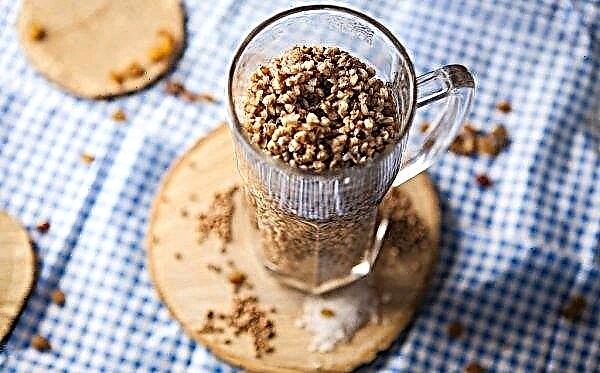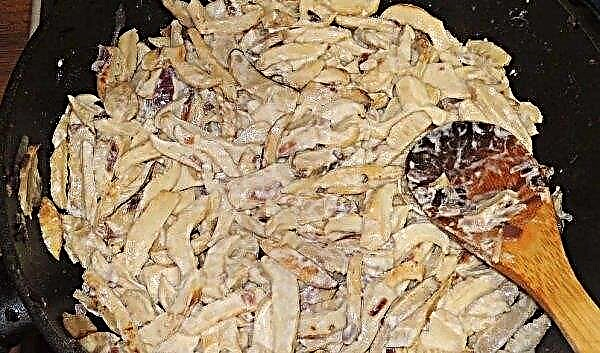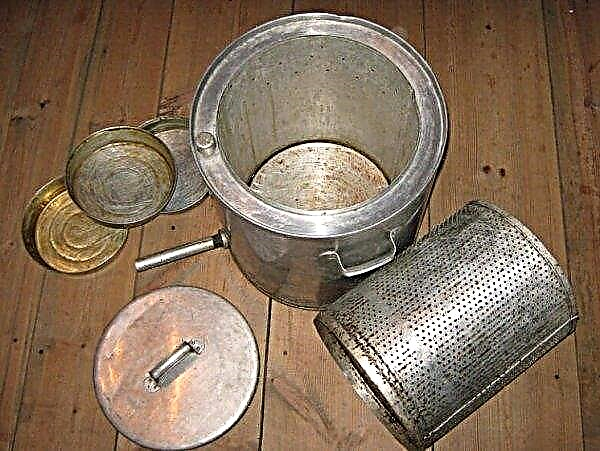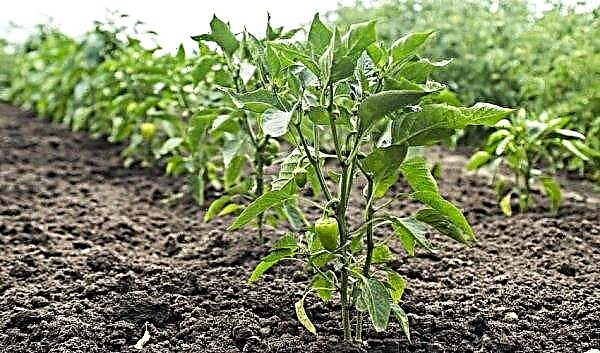Plum Greenclod has long gained popularity among gardeners. Since it is somewhat different from ordinary plums, for proper cultivation it is necessary to familiarize yourself with the main characteristics of its varieties, and in addition, with the characteristics of planting and subsequent care. You will learn about these and other details from the review.
Description and characteristics of greengage plums
Greengage is a fruit tree, a subspecies of home plum that is part of the Pink family. It differs from other plums in taste, especially juicy and soft fruits. The main characteristics of trees and fruits are described below.
Did you know? The greengage plum is named after the daughter of the French king Louis. In French, the word means Queen Claude.
Tree description
Trees of this type of plum are more accurate, and the crown requires pruning. The growth of most varieties does not exceed 5–7 m. The leaves are placed on elongated petioles, they are dense, slightly elongated and lowered. The crown of the trees is round, young branches are elastic, red-green or brown, the edge is short. The bark of adult trees is gray. The greengage begins to bloom in late spring (usually in early May); for pollination of infertile and partially self-fertile varieties, planting of pollinating trees or artificial pollination is used.
The bark of adult trees is gray. The greengage begins to bloom in late spring (usually in early May); for pollination of infertile and partially self-fertile varieties, planting of pollinating trees or artificial pollination is used.
Did you know? The plum tree came from the cross of cherry plum and thorns more than 2000 years ago, so there is no wild plum - except for plants that grew from seeds that accidentally fell into the wild.
Fruit Description
The greengage fruits are oval, 4-5 cm in size, weighing 20-50 g. The color of the berries is yellow-green or dark blue, in some varieties the shade reaches black. On the fruits there is a coating that is easy to erase. The surface is a little rough. Plum branches are fastened with a pubescent short peduncle.
Advantages and disadvantages
Like any culture, greengage plum has characteristic advantages and disadvantages. There is one drawback: trees undergo root rot, which is due to excessive moisture.
- Advantages of the subspecies:
- gives large fruits that are stored for a long time;
- its plums have good taste;
- shows high productivity;
- Demonstrates frost resistance up to -20 ° С;
- resistant to drought.
The most popular varieties and their characteristics
A variety of varieties is a subspecies of the greengage plum. Next, the most common of them are briefly characterized.
Important! Even self-fertile greengage varieties often require pollinators to obtain the maximum yield.
Green
The height of the greengage green trees is 6-7 m. He is considered the founder of the remaining varieties. Fruits weighing 20 g have a green-yellow hue and a slight coating on the peel. The pulp is light, actually transparent, fleshy and sweet. Fruits appear after 5 years of plant growth. In the first year of fruiting, 23-30 kg of plums ripen on the trees; in 10 years, the yield will be 40-60 kg. Harvesting is carried out at the end of summer.
Yellow
The greengage yellow tree is fast-growing and resistant to frost, 6 m tall. Plums are small in size, oval in shape. The flesh of the plum is juicy, green-yellow in color, has a sour-sweet finish. Their maturation occurs at the end of summer and lasts until the beginning of autumn. The yield of this variety is 30 kg per tree. Fruits withstand transportation well.
White
The variety is famous for its unusual matte-white color of the fruit. The pulp is light yellow, in fact transparent, juicy and tender. The fruits of Greengage white are not suitable for canning, so they should be consumed fresh. Trees of this variety tolerate both frost and drought. The first fruits appear 3 years after planting.
Blue
Medium hardy variety, showing resistance to many diseases. The fruits are purple-blue in color, there is a coating on the peel. The plum weighs about 35 g; it tastes juicy, with acidity. Begins to bear fruit in 3 years.
Altana
Frost-resistant grade, withstands up to -30 ° C; in addition, it is resistant to drought and disease. Fruits of a purple color, have amber, juicy pulp. From a tree, you can get 90 kg of the crop. One berry weighs 45 g. Productivity is reduced every 4-5 years. The alternative name of the variety is Violet large. It was bred due to a mutation of seedlings and seeds of Greenclod green.
De beauvais
A variety of Belgian origin, De Beauvais, like the previous one, is obtained from green leaves of Greengage. Harvesting is carried out at the end of September. The variety is demanding on lighting and heat. The pulp is juicy, with a nutmeg aftertaste. The fruits are yellow-green in color, a blush is noticeable on the sides; have a high keeping quality.
Early
Greenclod trees are early tall, reaching 6 m. The variety is resistant to frost. Harvesting is carried out from late July to August. Fruits of a yellow-orange color with a characteristic blush. On the palate, they are sweet and sour with a honey aftertaste, have a high shelf life. This variety is affected by the moth.
Collective farm
The Greencod variety is collective farm, or, colloquially, the Collective Farm Girl, was bred by breeder I.V. Michurin by cross-pollination of Greenclod green with prickly plum in the 19th century. The height of the trees is 3 m; they withstand frosts to -35 ° C and bear fruit every year, starting from the 4th year of life. Plum yellow-green with a touch of light, sweet and juicy. The weight of one plum is about 20 g. Collective farm greenhouse can be used for various canned foods, preserves and sweet snacks.
Soviet
Frost-resistant grade, withstands up to -30 ° C. Created in Russia in 1980 by cross-pollination of Renklod Ulyanischev and plum Record. The height of the tree is 3 m. The collection is made at the end of August. The first fruits can be harvested after 4 years. Fruits of dark purple color with a coating on the skin, weighing 40 g. The flesh is golden, sweet, juicy, not sugary, with sourness. When freezing, the fruits lose their shape, become loose, but do not lose their taste. Suitable for making jam, jam, desserts, it is not recommended to use for preservation. Soviet greengage is affected by polystigmosis.
Karbysheva
The variety was bred in 1951 in Ukraine. The tree is tall and fast-growing, with a dense crown. He needs pollinators, such as the Greengage Early and Greenhouse Green. The harvest of Greenclod Karbyshev is carried out in early August. Fruits are scarlet, weighing about 50 g; the flesh is dark yellow. Plum is juicy and sweet, the taste is high. It makes excellent prunes.
Tambovsky
The greengage of Tambovsky, or Tatar - a hybrid of greengage of green and plum Skorospeli red. Trees of medium height, resistant to frost. Fruits of a small size have a dark purple color, their flesh is sweet and juicy. The first crop can be harvested in 3 years. This variety is not self-pollinating, and also exposed to fungal diseases.
Tenkovsky
The height of the variety trees is 3 m. Plums of dark purple color grow small in size, weighing 15–20 g. When tasting, the peel is slightly bitter. The pulp is yellow, friable and granular, sweet and sour to taste. Harvesting is carried out in the second half of September. The first fruits can be harvested in 3-4 years.
Michurinsky
On a medium-sized tree of this variety, small red fruits grow. Harvest ripens by early September. The plum is juicy, slightly sour; possesses high keeping quality. The first fruits can be harvested after 3 years.
Presidential
This variety is also called English plum. To get it, breeders combined the following varieties: Greengage Altana, Hungarian Azhanskaya and Great Blue Plum. Usually the tree reaches 3 m in height. The presidential greengage is well tolerated by the cold. Large plums have a purple color. Harvest appears 4 years after planting.
Optimal conditions for growing
To get a rich harvest, you must follow the growing conditions. First of all, seedlings need to be planted in suitable soil.The landing soil must be:
- loose;
- fertile;
- with low acidity.
Planting seedlings should be in a well-lit, not windy area, as drafts can slow the growth of the plant or reduce the size of the fruit. It is also necessary to check the absence of groundwater, since excess moisture will lead to various diseases, even root decay. It is best to grow trees in the hills.
Avoid lowlands, because after winter and rains all water accumulates in such places. It is recommended to plant a greengage near a fence or any building - this way you can save plants from strong winds or drafts without unnecessary trouble. If the selected variety cannot independently pollinate itself, nearby pollinating trees should be planted.
Landing rules
Before embarking on a planting, you need to try to get a healthy seedling. When choosing young plants, the following factors must be considered:
- seedlings are of two types - grafted and root; the latter option has a significant advantage, because after freezing, recovery is faster;
- optimal age - 2 years;
- they should have 3-4 lateral branches and 3-5 strong roots, the length of which is 25 cm;
- seedlings imported from the southern regions are unlikely to take root in the north.
 Planting is done in the spring from March to April, until the moment when the buds open. It is not recommended to plant a seedling in the fall, as sharp cold weather can occur. When planting several plants, it is necessary to make gaps between the pits of 2-3 m.
Planting is done in the spring from March to April, until the moment when the buds open. It is not recommended to plant a seedling in the fall, as sharp cold weather can occur. When planting several plants, it is necessary to make gaps between the pits of 2-3 m.Progress:
- At the initial stage, you need to dig a hole - this is done 12-14 days before planting, by then the soil will settle. The pit is 60 × 80 cm in size (depth and width). When digging a hole, it is required to divide the soil: the upper layer in one direction (it is fertile), and the lower layer in the other.
- Then fill the hole with fertilizer from humus (15 kg), fertile soil, superphosphate (100 g) and potassium salt (60 g).
- In the center of the hole you need to hammer a peg, it will serve as a support.
- Water abundantly.
- Make a mound of soil around the support.
- Before planting, you need to inspect the roots of the seedling, prune damaged ones.
- Set a tree on the knoll and attach it to the support, the roots must be spread over the entire area.
- Pour the seedling with the top layer of soil, compact, water.
- Mulch the soil around the seedling - this is necessary to prevent moisture evaporation.
Video: planting plum seedlings
- As pollinators will not work:
- Chinese plum
- common cherry plum and hybrid;
- blackthorn.
If there are no other options, it is better to use artificial pollen. 12 months after planting from a plum, it is necessary to cut off the inflorescences - This procedure is carried out in order to get a plentiful harvest next season. And for young, fragile branches that are damaged under the weight of the fruit, support is needed, they retain the plant and its shape.
Important! The root neck after planting should be 3-5 cm above the ground.
Planting Care Features
Care of the greengage plum consists in timely fertilizing, watering, as well as in cutting dry and weak shoots and shelter for the winter.
Soil care
The necessary soil care is as follows:
- Watering. It is necessary to water 5-6 times a season, for this, settled water of room temperature is used. One tree consumes 40–80 liters of water.
- Loosening and weed removal. The trunk circle must be regularly cleaned of weeds and loosen the soil with a depth of 6-8 cm. This is necessary so that the soil more easily absorbs moisture.
- Mulching. It is used to warm the root system and preserve moisture. In addition, it simplifies soil care, as it does not allow weeds to germinate, and also reduces the need for cultivation.

Mulch can be varied:
| Name of raw material that can be used for mulching | Coating thickness |
| Fresh grass or hay | 10-15 cm |
| Nettle finely chopped | 5 cm |
| Sawdust | 7 cm |
| Tree bark | 5-7 cm |
| Moss | 10 cm |
| Rotted needles | 3-5 cm |
Top dressing
In the first year after planting, fertilizer does not need to be applied, but after some time there will be a need to feed the plum with nutrients. Fertilizer is applied in several periods.
Before the formation of inflorescences, the composition of the fertilizer consists of:
- potassium salt - 40 g;
- mineral fertilizers - 325 g;
After application, the plant is watered. During the growing season, planting is fertilized with a solution of 10 g of urea in 5 l of water. The ingredients are mixed, then the plant is watered with them. After flowering, the following ingredients are mixed and introduced into the soil:
After flowering, the following ingredients are mixed and introduced into the soil:
- Mullein solution 0.3% - 10 l;
- superphosphate - 50 g.
During the ripening period of the fruit, it is necessary to water the trunk circle with this mixture:
- urea - 80 g;
- nitrophoska - 180 g;
- water - 20 l.
Video: feeding plums
In autumn, before preparing the plum for winter, the soil around it is fertilized with this solution:
- manure - 15 kg;
- superphosphate - 150 g;
- mineral fertilizer - 50 g.
Pruning
Pruning is best done in early spring, before the first leaves appear, or in summer.
Important! After trimming the crown, the places of cuts must be treated with garden var.
It should be carried out in such periods:
- First year. Form a crown. 10 skeletal branches are cut at the same distance at an angle of 45 ° from the trunk.
- Second year. Growth is removed, up to a size of 25 cm.
- Third year. The shoots on the branches are trimmed to a length of 30 cm.
- Fourth year. Since the main crown already has the necessary shape, it is enough to carry out sanitary pruning. To do this, cut off dried, damaged branches. It is important to remove excess processes in time so that the crown is not thick, otherwise the plant will suffer from a lack of sunlight.

Video: prune pruning
Winter preparations
Fruit trees do not tolerate frost and cold. To planting survived the winter season, it is necessary to further prepare them for this. Shelters are created for young plants. As materials for them can be:
- hay;
- lapnik;
- sackcloth.
 To protect against parasites and rodents, it is necessary to bleach the trunk with slaked limeFor overwintering of adult trees, they are sprinkled with sawdust and humus. So, you have learned about a promising variety of plums for gardening. Now you can choose the most suitable variety of greengage plums to grow tasty and juicy fruits. The rules for watering and fertilizing the soil will tell you how to keep the tree healthy and increase its productivity.
To protect against parasites and rodents, it is necessary to bleach the trunk with slaked limeFor overwintering of adult trees, they are sprinkled with sawdust and humus. So, you have learned about a promising variety of plums for gardening. Now you can choose the most suitable variety of greengage plums to grow tasty and juicy fruits. The rules for watering and fertilizing the soil will tell you how to keep the tree healthy and increase its productivity.

